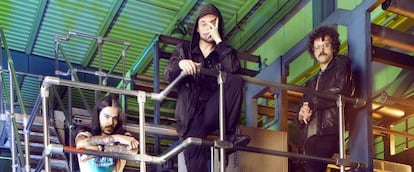Fair treatment for street artists
Post-graffiti painters show off their work at EL PAÍS Arco stand

Some graffiti is “dirty” and invasive, while other types of spray-painting try to enhance the cityscape. This global phenomenon, so typical of the world’s major metropolises, takes on added relevance at a time when the voices of the people on the street are fighting to make themselves heard. Six representatives of an artistic movement known as post-graffiti have been invited to show their work at the EL PAÍS stand at Arco 2012.
Suso33, Sixeart, Spok, 3ttman, Neko and Nuria Mora will create specific pieces for the art fair, and also do some live work in performances that will get the public involved in the action. In 2008, some of these artists were asked to paint the façade of London’s Tate Modern, considered one of the world’s temples of contemporary art.
Yet for all the institutional acceptance, one cannot ignore the fact that a state of all-out war still exists between graffiti artists and local governments. It is an expensive war, too. Madrid spends around six million euros a year eliminating nearly 45,000 examples of graffiti from walls; Barcelona devotes four million euros to this endeavor. The railway company Renfe spent around three million euros in late 2010 to clean up its cars and installations. And makers of street furniture — particularly bus shelters — are forced to replace screens which are often ruined by paint, acid and sharp instruments.
Although the fines can reach 6,000 euros, the graffiti keeps cropping up everywhere. Why? Are its authors all the same? What is their point? Are they organized? Are they delinquents, artists, or just louts? There is a bit of everything out there: mere “tags” that make cities look uglier and paintings that lend a new look to abandoned spots. And perhaps in order to keep their distance from the kind of invasive graffiti that has no respect for its architectural surroundings, graffiti artists have coined new terms such as street art, urban art or post-graffiti, a more creative trend that all the guests at Arco share in.
Graffiti theater
An extreme example of this is Suso33, who has occasionally been applauded on the street as he worked. That’s because what he does goes far beyond spray-painting, and becomes a show in its own right. His performances have been known to include dancers and musicians, besides video projections. It is art in action, conducted at the speed of graffiti.
Although he admits that illegality is part of the game, “my intention is not to do any harm. Painting an empty lot is not the same as painting in a city center.”
Suso33, whose real name is Félix, studied fine arts for a couple of years, and he has painted sets for television, theater and opera. “Back in college, graffiti was frowned upon. These days I get calls asking me to give lectures,” he says. When he performs, he wears an outfit that is part superhero, part clown and part character from Commedia dell’arte. “I make theater out of graffiti,” he says.
Tu suscripción se está usando en otro dispositivo
¿Quieres añadir otro usuario a tu suscripción?
Si continúas leyendo en este dispositivo, no se podrá leer en el otro.
FlechaTu suscripción se está usando en otro dispositivo y solo puedes acceder a EL PAÍS desde un dispositivo a la vez.
Si quieres compartir tu cuenta, cambia tu suscripción a la modalidad Premium, así podrás añadir otro usuario. Cada uno accederá con su propia cuenta de email, lo que os permitirá personalizar vuestra experiencia en EL PAÍS.
¿Tienes una suscripción de empresa? Accede aquí para contratar más cuentas.
En el caso de no saber quién está usando tu cuenta, te recomendamos cambiar tu contraseña aquí.
Si decides continuar compartiendo tu cuenta, este mensaje se mostrará en tu dispositivo y en el de la otra persona que está usando tu cuenta de forma indefinida, afectando a tu experiencia de lectura. Puedes consultar aquí los términos y condiciones de la suscripción digital.








































